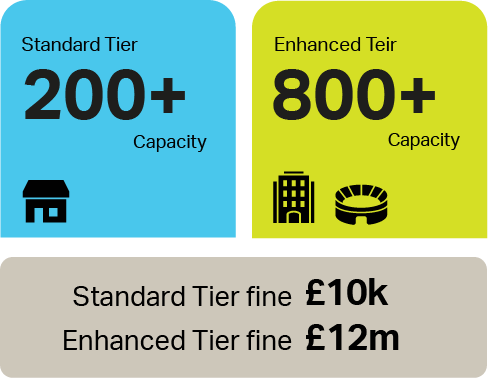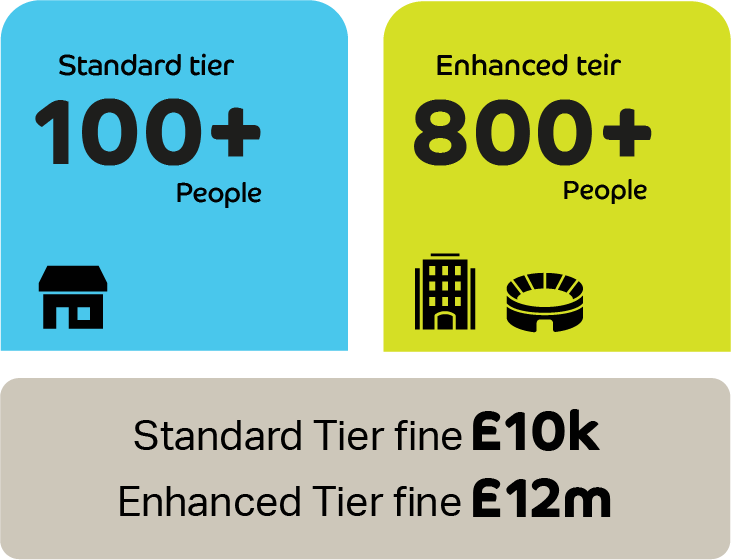Martyn’s Law, also known as the Protect Duty, is a proposed legislation in the United Kingdom aimed at enhancing public safety by requiring owners and operators of publicly accessible locations to take steps to protect people from terrorist attacks. It is named in honour of Martyn Hett, one of the victims of the 2017 Manchester Arena bombing.
Enforcing Martyn’s law
A new inspection and enforcement regime will be set up, not simply to ensure compliance with Martyn’s Law but also to promote a culture of protection in venues. In practice, it will operate in a similar way to the system that regulates fire safety.

There will be penalties for serious breaches, but these will be fair and proportionate - for Standard Tier venues fines would be up to £10,000, while for the Enhanced Tier the penalty could be as much as £18 million.

However, the idea is not that Martyn’s Law should be punitive and a burden. The aim is for the Government to give venues the straightforward guidance and simple tools they need to help prevent terror attacks and save lives.
FAQs
Why was Martyn’s Law introduced?
Martyn’s Law was introduced in response to the growing threat of terrorism and to ensure that venues are better prepared to respond to such incidents. It aims to establish a consistent and effective approach to security across a variety of public spaces, helping to prevent future attacks and minimize their impact.
What types of locations are affected by Martyn’s Law?
The law applies to a wide range of publicly accessible locations, including but not limited to:
- Concert halls and arenas
- Shopping centres
- Public squares and parks
- Sports stadiums
- Large entertainment venues
- Places of worship
- Educational institutions
Essentially, any place where large numbers of people gather and could potentially be targeted by terrorists.
What will be the key requirements of Martyn’s Law for venue operators?
Risk Assessment: Conducting thorough risk assessments to identify potential vulnerabilities and threats.
Mitigation Measures: Implementing appropriate and proportionate measures to reduce the risks identified, which may include physical security measures, staff training, and emergency response planning.
Training and Awareness: Ensuring that staff are adequately trained to recognize and respond to security threats.
Collaboration: Working with local authorities, emergency services, and other stakeholders to enhance overall security and preparedness.
Information Sharing: Sharing relevant security information and intelligence with appropriate authorities and other operators.
How will compliance with Martyn’s Law be monitored and enforced?
Compliance with Martyn’s Law will be monitored and enforced by designated regulatory bodies, which may include local authorities and other government agencies. These bodies will have the authority to conduct inspections, review risk assessments and mitigation plans, and take enforcement action if necessary, including issuing fines or other penalties for non-compliance.
When is Martyn’s Law expected to come into effect?
The exact timeline for the implementation of Martyn’s Law is still being determined, as it is subject to the legislative process. However, the UK government has expressed a strong commitment to moving forward with the legislation, and it is anticipated to be enacted in the near future.
The venues that Martyn’s Law affects
Under Martyn’s Law (officially The Terrorism [Protection of Premises] Bill), big venues like the Manchester Arena are classified as Enhanced Tier. That covers qualifying publicly accessible spaces or events with a capacity of 800 plus. Qualifying smaller venues and events that cater for 100 up to 799 people are classified as Standard Tier.


Indoor events
A ‘publicly accessible building’ can either be a venue that’s entered by express permission (by ticket for example), or one that the public can go into without restriction – as in a hotel.
Open air events
Open air events in parks and outdoor spaces only come under Martyn’s Law if entry is strictly by permission – needing a ticket, membership or invitation. An open-air concert is one example.
Places of worship and education
These will both be classified as Standard Tier premises, even if their capacity is 800 people or over – unless they charge a fee for admission. And they will still have to comply with existing safety and safeguarding rules, which are monitored independently.
Village halls and community centres
Sadly, terrorists have attacked a wide range of venues in recent years and there’s no guarantee your local village hall won’t be a target. Most of these local community centres will come under the Standard Tier category.
The venues Martyn’s Law does NOT apply to
Under the current proposals, the following venues are outside the scope of Martyn’s Law:
- Private dwellings
- Offices
- Premises that come under existing transport security regulation, such as airports and ferry ports.
Theatres
Cinemas
Concert halls
Arenas
Cafés
Clubs
Music venues
Pubs and bars
Restaurants
local government locations
town halls
Child care
Schools
Universities and colleges
Conference centres
Museums and galleries
Exhibition halls
Stores
Shopping centres
Stadiums and Arenas
Sports facilities
Large-scale event venues
Ice rinks
Gyms
Public sports/leisure centres
Temples
Churches
Mosques
Synagogues
Buddhist temple
Gurdwara
Hospitals
Health Centers
Large medical facilities
Museums
Art Galleries
Historic Buildings
Monuments
Holiday parks
Hotels
Public transport
Train/bus stations
Ports
Airports
Airports: Major and regional airports
Train and Bus Stations
Ports and Ferry Terminals



